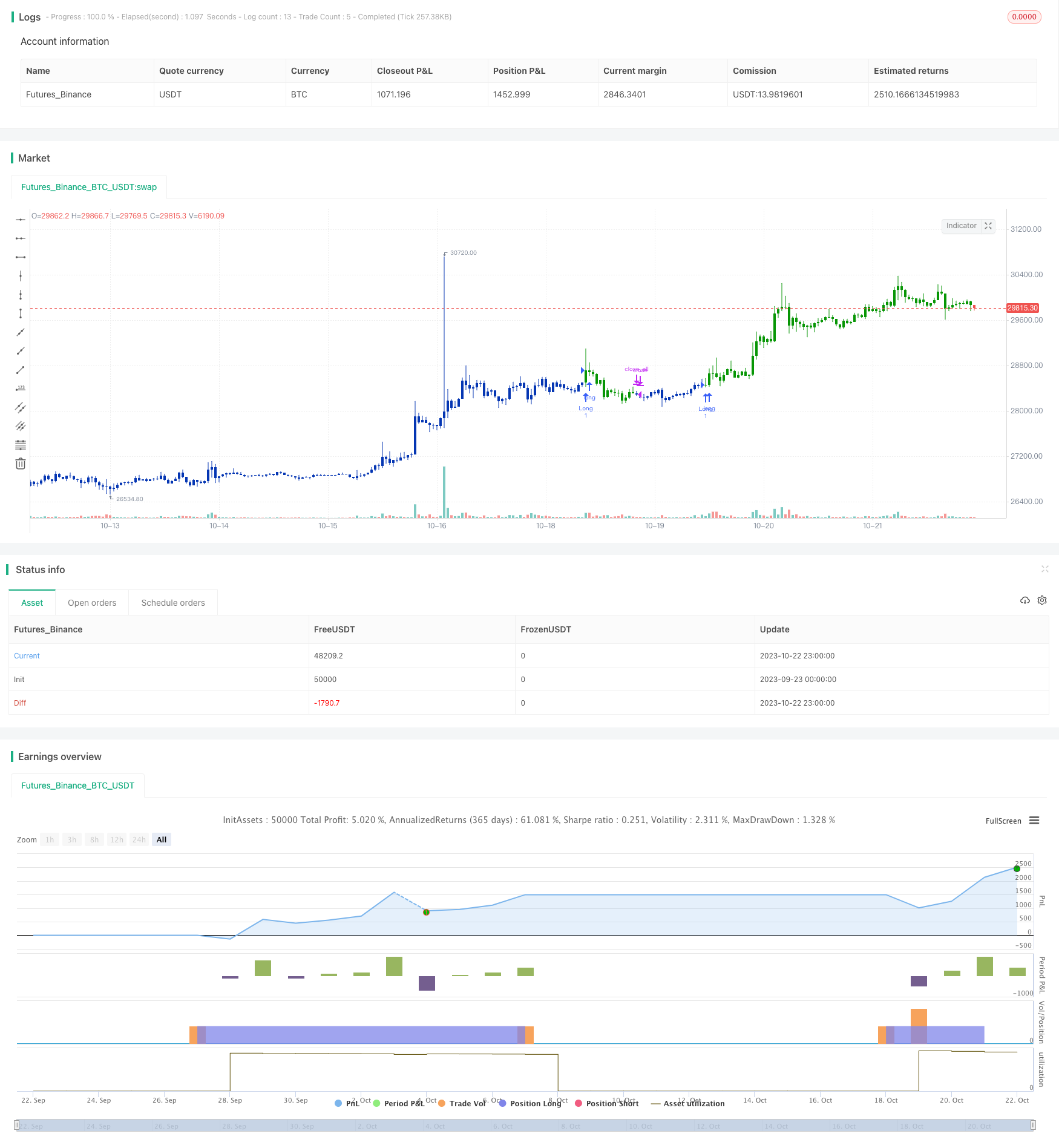
概述
该策略是一个联合策略,结合了趋势反转策略和统计波动率策略,以获取更强的交易信号。
策略原理
该策略由两部分组成:
趋势反转策略
- 使用123形态判断趋势反转点。具体来说,如果收盘价连续2日上涨,且9日Stochastic慢线低于50,则看涨;如果收盘价连续2日下跌,且9日Stochastic快线高于50,则看跌。
统计波动率策略
- 使用极值法计算近30日的统计波动率。如果波动率高于0.5%则看涨,如果低于0.16%则看跌。
最后,如果两种策略信号一致,即都是看涨或看跌,则产生交易信号;如果不一致,则不进行交易。
策略优势分析
该策略联合应用了两种不同类型的策略,可以提高信号的可靠性。
123形态判断能准确抓取趋势反转点,避免被突发性价格变动误导。
统计波动率反映了最近一个月的市场波动情况,可以过滤出波动率较高、交易机会较多的时段。
两种策略互为验证,结合使用更能抓住市场关键的转折点,从而获得更准确可靠的交易信号。
风险分析
123形态无法完全避免假突破带来的风险。如果出现异常震荡,可能会误判信号。
统计波动率仅考虑历史数据,无法预测未来波动趋势。如果市场波动突然放大或收缩,也容易产生错误信号。
两种策略都依赖参数优化。如果参数设置不当,信号质量将大打折扣。
联合策略虽提高了可靠性,但也可能错过某些较强的单一信号。
优化方向
结合更多指标,如布林带、KDJ等,形成投票机制。
增加机器学习算法,利用更多历史数据判断趋势反转概率。
设置阈值筛选信号强弱,避免噪音干扰。
优化参数设置,针对不同品种、周期进行参数调整。
增加止损机制来控制联合策略的风险。
总结
该策略通过联合应用趋势反转策略和统计波动率策略,提高了信号质量,能在市场关键转折点给出比较准确的交易指令。但也需要注意误判风险和参数优化问题。结合更多指标和机器学习等手段进一步优化,可以获得更稳定可靠的交易信号。
策略源码
/*backtest
start: 2023-09-23 00:00:00
end: 2023-10-23 00:00:00
period: 1h
basePeriod: 15m
exchanges: [{"eid":"Futures_Binance","currency":"BTC_USDT"}]
*/
//@version=4
////////////////////////////////////////////////////////////
// Copyright by HPotter v1.0 31/07/2021
// This is combo strategies for get a cumulative signal.
//
// First strategy
// This System was created from the Book "How I Tripled My Money In The
// Futures Market" by Ulf Jensen, Page 183. This is reverse type of strategies.
// The strategy buys at market, if close price is higher than the previous close
// during 2 days and the meaning of 9-days Stochastic Slow Oscillator is lower than 50.
// The strategy sells at market, if close price is lower than the previous close price
// during 2 days and the meaning of 9-days Stochastic Fast Oscillator is higher than 50.
//
// Second strategy
// This indicator used to calculate the statistical volatility, sometime
// called historical volatility, based on the Extreme Value Method.
// Please use this link to get more information about Volatility.
//
// WARNING:
// - For purpose educate only
// - This script to change bars colors.
////////////////////////////////////////////////////////////
Reversal123(Length, KSmoothing, DLength, Level) =>
vFast = sma(stoch(close, high, low, Length), KSmoothing)
vSlow = sma(vFast, DLength)
pos = 0.0
pos := iff(close[2] < close[1] and close > close[1] and vFast < vSlow and vFast > Level, 1,
iff(close[2] > close[1] and close < close[1] and vFast > vSlow and vFast < Level, -1, nz(pos[1], 0)))
pos
SV(Length,TopBand,LowBand) =>
pos = 0.0
xMaxC = highest(close, Length)
xMaxH = highest(high, Length)
xMinC = lowest(close, Length)
xMinL = lowest(low, Length)
SqrTime = sqrt(253 / Length)
Vol = ((0.6 * log(xMaxC / xMinC) * SqrTime) + (0.6 * log(xMaxH / xMinL) * SqrTime)) * 0.5
nRes = iff(Vol < 0, 0, iff(Vol > 2.99, 2.99, Vol))
pos := iff(nRes > TopBand, 1,
iff(nRes < LowBand, -1, nz(pos[1], 0)))
pos
strategy(title="Combo Backtest 123 Reversal & Statistical Volatility", shorttitle="Combo", overlay = true)
line1 = input(true, "---- 123 Reversal ----")
Length = input(14, minval=1)
KSmoothing = input(1, minval=1)
DLength = input(3, minval=1)
Level = input(50, minval=1)
//-------------------------
line2 = input(true, "---- Statistical Volatility ----")
LengthSV = input(30, minval=1)
TopBand = input(0.005, step=0.001)
LowBand = input(0.0016, step=0.001)
reverse = input(false, title="Trade reverse")
posReversal123 = Reversal123(Length, KSmoothing, DLength, Level)
posSV = SV(LengthSV,TopBand,LowBand)
pos = iff(posReversal123 == 1 and posSV == 1 , 1,
iff(posReversal123 == -1 and posSV == -1, -1, 0))
possig = iff(reverse and pos == 1, -1,
iff(reverse and pos == -1 , 1, pos))
if (possig == 1 )
strategy.entry("Long", strategy.long)
if (possig == -1 )
strategy.entry("Short", strategy.short)
if (possig == 0)
strategy.close_all()
barcolor(possig == -1 ? #b50404: possig == 1 ? #079605 : #0536b3 )